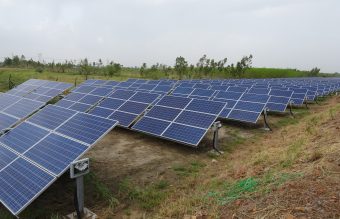
Following on from their ‘toolbox’ on high energy prices in 2021, today the European Commission set out a highly anticipated RePower EU Communication that seeks to address the dual energy security and price challenges facing Europe right now.
As Europe stands in solidarity with the people of Ukraine, European Commission Vice-President Frans Timmermans presented an energy strategy that aims to disentangle Europe from Russian gas as soon as possible, while protecting citizens from painful – and increasing – energy price shocks.
Walburga Hemetsberger, CEO of SolarPower Europe said: “The EU needs to become independent from Russian gas and oil as soon as possible. Solar is set to deploy over 30 GW, including 1.5 million solar rooftops, by the end of 2022. With the right frameworks in place, 1 TW of solar capacity is within reach for Europe by 2030. European solar deployment has surpassed expectations year after year, succeeding in some of the most difficult market circumstances. We call on the European Commission to recognise the true power of solar, and set the ambition needed to achieve our climate and security goals.”
Commission proposals highlighted the role of rooftop solar in repowering the EU, aiming to install 15TWh of solar rooftops before the end of 2022. Including the rooftop solar goal, the RePower EU strategy sets out 420GW of additional EU solar capacity by 2030, bringing total solar installation in the EU to 565 GW.
SolarPower Europe’s business-as-usual, most-likely scenario already predicts 672 GW of EU solar by 2030. The necessary level of ambition through an accelerated, high scenario can achieve over 1 TW of solar in the EU by 2030.
More:
In response to the European Commission’s proposals, and in recognition of the renewed geopolitical urgency of the renewables transition, SolarPower Europe has published a pathway to the solar TW level in Europe. The document presents market intelligence outlining the realistic scope of solar expansion, and sets out four policy asks to get there:
1. Multiply rooftop PV development through mandatory solar on new buildings, bans on fossil-fuel boilers, and significant investment.
2. Facilitate utility-scale development by freezing grid connection fees, and mandating member states to identify suitable solar PV sites, aiming to fast-track developments.
3. Pave the way for smart solar and hybrid projects using dedicated CEF-E and RRF funding, and a new EU Commission taskforce for hybrid projects access to flexibility markets.
4. Accelerate the deployment of EU solar PV manufacturing capacity with EUR 1bn de-risking funding from InvestEU & Innovation Funds.
Within RePower EU’s 420 GW solar goal, the proposals aim to frontload solar installation and increase deployment rates by 20 percent. An additional 80 GW of renewable capacity is set aside to accommodate higher production of renewable hydrogen.
Jorgo Chatzimarkakis, CEO of Hydrogen Europe said: “We welcome today’s communication of the European Commission which highlights how hydrogen can ensure clean energy independence. Hydrogenewables are the cornerstone of a resilient economy and energy self-reliance. It is ever more important to repower the EU by replacing, repurposing, and reinvesting.”
Annex 2 of the RePower EU Communication provides key principles for Member States when setting up infra-marginal profit fiscal measures. The guidance establishes that such measures should not continue later than 30th June 2022, and provides criteria to calculate the basis for such taxes.
Naomi Chevillard, Senior Policy Advisor at SolarPower Europe said: “Retroactive windfall profit taxes on revenues of renewables must be handled with great care: by legitimising retroactive interventions on market mechanisms, they create a precedent that could seriously hamper investment signals in renewables.”
“We welcome the common approach proposed by the European Commission and the clear time limit of 30th June 2022, which should ensure that the measures are limited in time, non-retroactive, and restricted to the extra profits. We call on the EU to ensure an increased scrutiny of the measures based on this guidance.”
Source: Solar Power Europe



